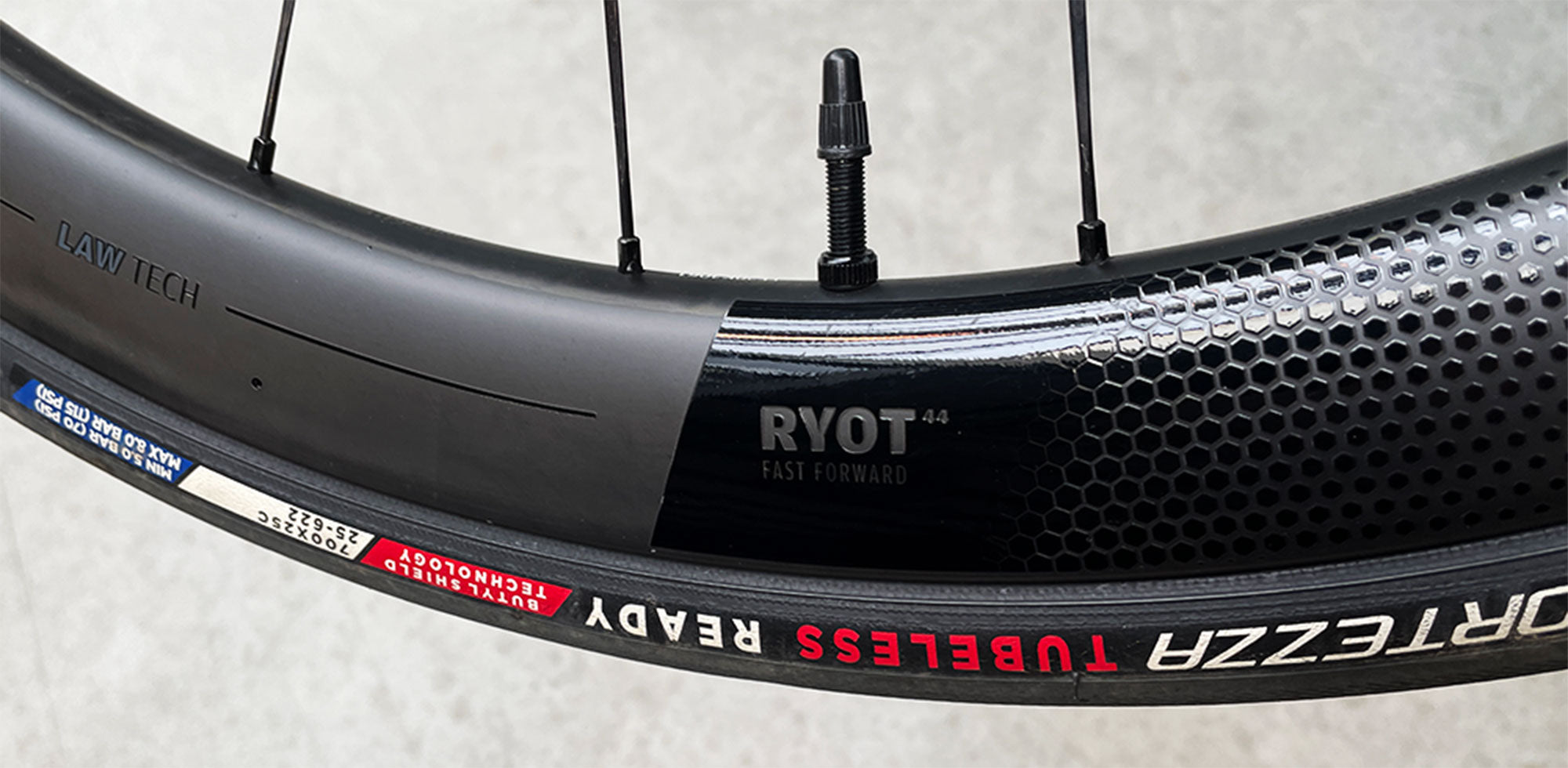All clincher wheels in our FFWD collection are "Tubeless Ready" so it won't be a surprise that we are true fans of riding with a tubeless setup. But what are tubeless tires, what are the benefits and how do you make your wheels tubeless? We list all these aspects for you in this article.
Watch our comprehensive video tutorial on how to install tubeless tires on FFWD wheels or check the steps in this document!
What are tubeless tires?
As the name suggests, with tubeless tires you ride without an inner tube. They massively improve puncture resistance thanks to an inventive solution that foregoes the inner tube for a latex sealant.
With tubeless tires, riders avoid the problem of punctures that you often get when something sharp gets through your outer tire, damaging the inner tube. Both tubeless tires and the rim bed are water- and airtight to ensure a tight grip where no air can escape. Tubeless tires use a sealant, which is a liquid latex that is inserted through the valve to seal small holes that would otherwise cause a flat. In most cases this sealant does its job within a few seconds and results in minimal loss of pressure.
The advantages of tubeless tires
Tubeless tires offer several advantages, and depending on your riding style and preferred terrain you ride on, it may make a perfect sense for an upgrade. Here are the top three benefits of tubeless tires.
1) Say goodbye to flats
Punctures are every cyclist's nightmare. But with tubeless tires, you significantly reduce your chances of getting a flat during your ride.
If you get a puncture, the sealant acts as an anti-puncture agent by sealing the hole within seconds. Should the hole be too big and the latex cannot seal the hole, you can always fit an inner tube to get you home.
Another major advantage of tubeless tires is that cyclists never have to worry about pinch flats (also known as snake bites) where the inner tube gets pinched between the rim and the outer tire. Especially when riding off road, such punctures occasionally occur and with tubeless tires this problem is a thing of the past.
2) Increased comfort with lower tire pressures
Comfort during your bike rides is an important issue and a lower tire pressure will result in a more comfortable ride. With tire pressure between 6 and 8 bar, road vibrations are trasmitted up through the bike and can become quite uncomfortable. With tubeless tires you can ride at a lower tire pressure which reduces those vibrations and that's a lot more comfortable.
Because you don't have to fear punctures, it is safe and even preferable to ride with lower pressure with tubeless tires. The tire allows to conform to the road surface and provide a more cushioned ride for increased ride comfort. Lower tire pressure also allows the tire to have better contact with the road surface. This leads to more grip and enhanced traction which provides better handling of your bike, especially riding off-road.
3) Less Rolling Resistance
The choice for riding tubeless tires will benefit the reduction in rolling resistance, especially when offroad conditions.
When a not-tubeless tire encounters a bump or other obstacle the wheel usually either moves up or sideways. This causes deceleration because the forward motion is interrupted which is often exacerbated by higher tire pressure. By running tubeless tires with lower pressure, the tire absorbs the shock better by deforming slightly upon the impact.
On offroad terrain with lots of rocks, roots and movement, the lower tire pressure makes a significant difference to rolling resistance.
Standard tires with an inner tube do not deform in the same way and thus do not absorb shock as efficiently. It is these seemingly small advantages that can quickly add up and become significant on certain types of (offroad) terrain.
By choosing a tubeless setup, riders can really feel their wheels rolling. They result in faster, smoother and more efficient riding and it takes away the fear and stress caused by flat tires.
The do's and don'ts of tubeless tires
With tubeless tires, there are some important steps that every cyclist should bear in mind to ensure optimal functioning of any tubeless setup.
The do's
- Always use a sealant for a safe, effective setup and puncture protection. Don't forget to replace it every three to four months as it may dry up and become lose its function.
- After mounting the tire and applying the sealant, let the wheel spin for a while and before you pump up the tire. This spreads the sealant well inside the tire surface so it can do its job properly.
The don'ts
- Do not attempt to install a tubeless tire unless you are experienced. In that case, have the job done by a bike mechanic.
- Don't try to install a non-tubeless tire in a tubeless setup. Without the stiffer bead on tubeless tires that holds it onto the rim, this can be extremely dangerous.
Are tubeless tires worth it?
You'll save weight, reduce flats, and will enjoy a smoother ride. Oké you'll also spend more money, spend more time mounting them, and just in case, you still have to carry an inner tube just like before.
The question of whether tubeless tires are worth it depends a lot upon the individual cyclist preferences and their riding style. But at the very least, fewer flats mean more time riding and less time stressing.
Are you convinced and ready for your tubeless experience? Discover our range of tubeless ready wheels over here.
Still have questions or want some advice on which set of wheels best suits your needs? Feel free to contact us and we'll be happy to help you to get on the road.
